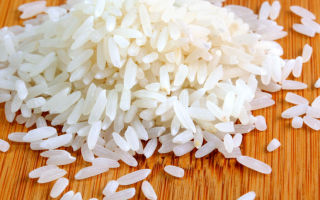Content
- 1 What is rice and where does it grow
- 2 Varieties of rice
- 3 Vitamins and minerals in rice
- 4 Nutritional value and calorie content of rice
- 5 Useful properties of rice
- 6 Is rice possible for pregnant and lactating mothers
- 7 Rice for children
- 8 The benefits of rice for weight loss
- 9 Features of eating rice for some diseases
- 10 The use of rice in traditional medicine
- 11 How rice is used in home cosmetology
- 12 How can rice be cooked and what is it combined with
- 13 Harm of rice and contraindications
- 14 Selection and storage of rice
- 15 Conclusion
The benefits and harms of rice are an important issue, since this cereal is present in almost every kitchen. To understand the effect of rice grains on the body, you need to study their properties and learn about how to use them.
What is rice and where does it grow
Rice is a cereal widely cultivated in tropical and subtropical regions of Asia, Africa, America and Australia. A distinctive feature of rice is its increased sensitivity to moisture levels. In arid regions, the culture simply does not grow, usually the cereal is grown directly in the water, rice also loves heat very much and dies from frost.
The spread of rice across the globe began many millennia ago from East Asia, and since then, the grain has become important in many national cuisines of the world. The culture is used not only in cooking, the properties of rice are used in medicine and industry.
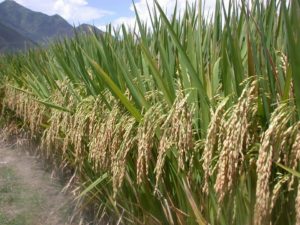
Varieties of rice
There are many types of rice, but most often you can find several of them in stores.
- White rice - rounded or long grains, which are thoroughly cleaned and polished during the production process. Despite the fact that the content of nutrients in cereals is slightly reduced, it is easiest to cook it, it takes 10-15 minutes.
- Brown rice - grains that have hardly been cleaned. When processing brown cereals, only the upper flower scales are removed. Groats require a longer and more thorough cooking, but the benefits of unpolished rice for the body are much greater, since almost all valuable substances are stored in it.
- Golden Parboiled Rice - grains that have not undergone grinding, but are free from shells and embryos. The variety is a cross between white and brown rice, it does not take much time to prepare cereals, and up to 80% of the original volume of nutrients is retained in it.
- Red rice - semi-polished grains with partially preserved bran shell. The properties of the product are very beneficial for the intestines, as the bran helps to cope with most digestive problems.
Thus, the benefits of rice varieties depend on the degree of processing of the grains - the less it is, the more valuable the cereal.
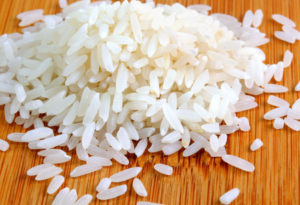
Rice that is sold in stores can have long or round grains. The benefits of round grain rice are almost the same as those of long grain varieties. The only difference is that round grains contain more starch and therefore are more boiled during processing.
Vitamins and minerals in rice
To assess the benefits and harms of white rice, you need to study the chemical composition.Each grain of cereal contains:
- vitamins H and PP;
- vitamins B1, B6 and B4;
- valuable minerals - iron, zinc, magnesium;
- cobalt, manganese and molybdenum;
- potassium, phosphorus and sulfur;
- chromium, chlorine and silicon;
- copper and selenium;
- cellulose;
- important amino acids for health.
Rice, on the other hand, is completely gluten-free, making it ideal for people with gluten intolerance.
Nutritional value and calorie content of rice
The composition of rice is represented mainly by carbohydrates - there are about 62 g of them in cereals. There are relatively few proteins in grains, only 7.5 g, and very little fat - about 2.6 g.
The calorie content of 100 g of dry rice grains is 303 kcal. However, the benefits and harms of boiled rice are that after processing it becomes less nutritious - only 115 kcal per 100 g serving.

Useful properties of rice
Regular consumption of rice grains brings great benefits to the body. In particular, rice:
- gently envelops the intestines and stomach and softens discomfort during inflammatory processes;
- removes slags and toxic substances in case of poisoning;
- strengthens blood vessels, and, therefore, has a positive effect on the heart system;
- relieves swelling and facilitates kidney function;
- liquefies phlegm and removes it from the lungs, due to which it is of great benefit for colds and lung diseases;
- serves as an effective diaphoretic and antipyretic agent;
- regulates metabolic processes and improves brain activity.
Rice and foods based on it are considered effective prevention of Parkinson's disease. Therefore, the beneficial properties of the product are highly recommended for the elderly, cereals protects against the development of senile dementia.
The benefits of rice for women
The benefits of rice for a woman's body is that this cereal contributes to the normal functioning of the reproductive system. Vitamin E in rice stimulates the production of sex hormones and prevents the development of infertility.
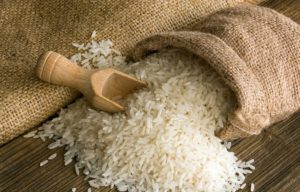
Also, the properties of the product are valuable for losing weight, the benefits and harms of rice on a diet are widely known. Eating cereals has a beneficial effect on the nervous system and protects against stress.
Why rice is good for men
The benefits and harms of rice for men are that the product enhances the production of the hormone testosterone. Grain has a positive effect on the work of blood vessels and the heart, thereby protecting men from the development of heart attacks and strokes.
In addition, improved blood circulation is good for the quality of sex life, this is also the benefit of rice for men. Grain is considered to be a light natural aphrodisiac.
Is rice possible for pregnant and lactating mothers
Rice groats are one of the healthiest for pregnant women. If you study the benefits and harms of rice during pregnancy, it will become clear that cereals help to cope with edema and indigestion during childbearing, strengthens the immune system and protects the expectant mother from colds. The nutrients in rice have a positive effect on the developing fetus and, in particular, on the bone and nervous systems.
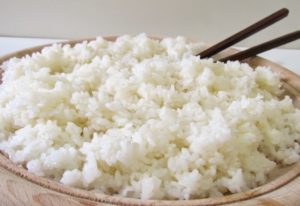
During lactation, rice is also very useful - you can introduce it into the diet just a couple of weeks after giving birth. Allergies in infants are extremely rare due to the properties of the product, so rice is completely safe during breastfeeding.
Rice for children
Hypoallergenic and vitamin-rich rice brings great benefits to the child's body - it supplies energy, strengthens muscle tissues, and stimulates healthy brain function. The product is very well accepted by the digestive tract and is easily absorbed.
It is important that there is no gluten in rice, so it can be given even to babies without fear of negative reactions. Usually, a useful product is introduced into the children's diet one of the first from 6 months of a child's life.
The benefits of rice for weight loss
Rice speeds up the metabolism and does not irritate the stomach and pancreas, so it is very useful on a diet. White rice for weight loss can be consumed during the week, combined with fresh vegetables and fruits.

The benefits and harms of rice for weight loss are manifested during fasting days, they can be carried out twice a week. For high-quality cleansing of the body, rice grains are slightly boiled without salt so that the cereals remain a little undercooked. Rice is divided into 4-5 servings and consumed throughout the day with plenty of water.
With such a diet, not only extra pounds go away. The benefit of undercooked rice is that, due to the increased fiber content, the body is rapidly freed from toxins, and the state of health improves.
Features of eating rice for some diseases
The product is one of the safest and rarely does harm even with chronic ailments. But in order for rice to be beneficial, you need to know how to take it for various ailments.
With diabetes mellitus
Refined white rice has a fairly high glycemic index - as much as 70 units. Therefore, with diabetes mellitus, it is better not to use it. Moreover, it is believed that the properties of the product can negatively affect health with a tendency to diabetes and even cause the development of the disease.
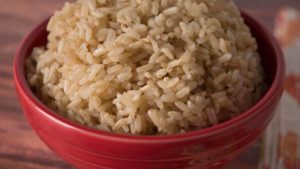
But the benefits and harms of brown rice for diabetics are in a different ratio - the positive effect of brown grains on the body is much greater. The glycemic index of brown rice is lower and equal to only 50 units, while the product has a good effect on metabolism, helps to lower blood glucose levels and protects against complications.
With pancreatitis
For inflammation of the pancreas, white rice is beneficial. Moreover, its valuable properties are manifested not only during the period of remission, but also in the phase of exacerbation; the product can be eaten within 3 days after the acute pain subsides.
In order for the benefits and harms of boiled rice in pancreatitis to have a beneficial effect on the body, the cereals need to be processed as carefully as possible - not only boiled, but also pre-chopped. Milk porridges, puddings, and vegetable soups are beneficial for your health.
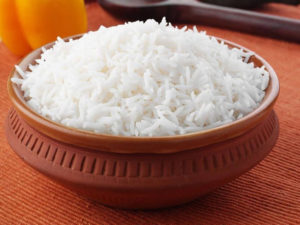
With gastritis and ulcers
The benefits and harms of polished rice are appreciated for irritated stomach mucous membranes - during gastritis and ulcers, you can use cereals. Before cooking, the rice should be soaked thoroughly to soften and boil thoroughly.
Eating rice for gastritis will not do harm only if there is no tendency to constipation - the product has anchoring properties.
The use of rice in traditional medicine
Most often, rice appears on tables in the form of porridge or a side dish for other dishes. But the medicinal properties of rice are also used in folk medicine - useful decoctions and infusions are prepared from its grains.
Cleansing the body with rice
Since the properties of the product help to free the body from toxins and toxins, the benefits and harms of rice cereals are purposefully used to cleanse the body. It is carried out as follows:
- white rice in the evening is poured with water and left to infuse in the refrigerator;
- in the morning, water is drained from a container with cereals, scooped up a small amount of raw grains, according to the number of years lived, and chewed without drinking water;
- 3 hours after taking rice grains, you can have breakfast with regular foods and drink water or tea.
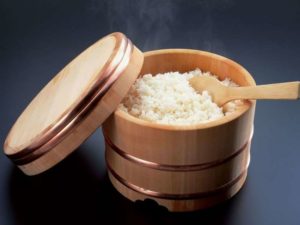
You need to carry out cleansing for 10 days. You need to take rice in the morning at approximately the same time, it is recommended to have dinner no later than 7 pm.During the cleansing course, you should not drink alcohol, you also need to give up fatty, spicy and smoked foods.
The beneficial properties of raw rice grains will contribute to the elimination of salts and toxins from the body and an overall improvement in well-being. Cleansing with rice can be carried out regularly, but the break between procedures should be at least 2 months.
Rice broth
The benefits and harms of rice water are widely known in home medicine. Prepare it like this:
- peeled white rice is washed several times until the water from under it becomes clear and clean;
- the cereal is poured with water in a ratio of 1: 7 and brought to a boil over medium heat;
- after boiling, the fire is reduced to a minimum, then covered with a lid and cooked for another half hour.
After 30 minutes, the rice is removed from the stove, the water from the cereal is poured into a separate container and cooled. The broth contains a high concentration of nutrients and helps well with a number of ailments.
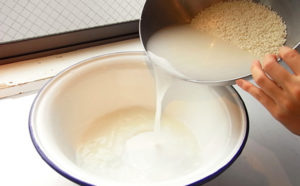
In case of poisoning
In case of food intoxication, you need to drink a useful broth of 120 ml on an empty stomach. You can take the product several times a day until you feel better.
With diarrhea
The properties of rice water will quickly stop diarrhea if you drink 100 ml of it at least 5 times a day. You can add a little salt to the drink, you need to use the product in between meals.
For gastritis and stomach pain
During an exacerbation of gastritis, a decoction of 200 ml should be taken in the morning and in the evening shortly before eating. In total, they drink the product for 2 weeks, and then take a break for a week.
For pancreatitis
In case of inflammation of the pancreas, rice broth should be mixed with an infusion of dandelion root in an equal ratio. They drink the remedy twice a day in the morning and in the evening, the total duration of treatment is 3 weeks.
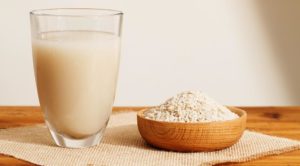
When vomiting
To get rid of nausea and vomiting, you need to drink a few sips of rice water 6 times a day. It is advisable to do this on an empty stomach.
Rice infusion (water)
On the basis of white grains of rice, not only a healing broth is made, but also an infusion. The benefits of rice water for the body lies in the fact that cereals do not undergo heat treatment, and the vitamin and mineral composition is retained in full.
It is very simple to prepare the infusion.
- Pour 200 g of white rice with cold water, remove all floating debris, then drain the water through a colander.
- The groats are washed again, then transferred to a glass or plastic container and poured with a liter of boiled water.
- After half an hour, the water is poured into a separate container and put into the refrigerator.
Rice water retains its beneficial properties for 3 days, then it is necessary to prepare a new infusion.
Water helps with many ailments, it is drunk with diarrhea and nausea, gastritis and a tendency to constipation. Rice infusion is good for colds as it has antipyretic properties. It is recommended to use the infusion during lactation for those women who have problems with the production of breast milk - the remedy helps to solve the problem.
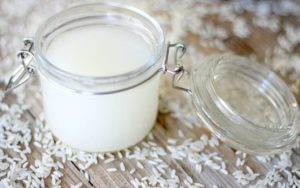
The dosage of rice water should be small - no more than half a glass at a time, and the product should be taken 2 to 4 times a day.
A useful infusion based on rice is used not only internally, but also externally, it can be used to treat wounds and dermatological inflammations.
How rice is used in home cosmetology
The benefits of rice for the human body are used in homemade self-care recipes. The properties of rice grains improve skin condition and help to strengthen and plump hair.
Rice for face skin
The benefits of rice water for the face are that the home remedy softens, rejuvenates and mattes the skin. You can wash your face with infusion on rice every day, then rinse it with cool water.
There are also many rice based masks. For example, the following remedy will help moisturize and slightly whiten the skin:
- white rice in the volume of half a glass is slightly boiled without salt and washed;
- add 2 large spoons of milk to the grains;
- rice is thoroughly kneaded into gruel.

The cooled mixture is applied to the face for a quarter of an hour. It is better to apply the mask twice a week, then the effect will not have to wait long.
The properties of another simple mask will help cleanse and moisturize the skin. They do it like this:
- 2 teaspoons of rice are mixed with 2 teaspoons of oatmeal;
- the ingredients are ground in a blender or coffee grinder;
- add 4 teaspoons of yogurt or kefir to the mixture;
- mix and spread over the face with massage movements.
The mask not only nourishes the skin, but also has the effect of a scrub, gently removing dead particles of the epidermis.
Rice decoction for hair
The benefits of rice water for hair is that the infusion on white rice grains helps with excessive fragility of hair, hair loss and dandruff. Using the product is very simple.
- A handful of grains are poured with clean water, drained and rinsed, the grains are again poured with water.
- Boil for 5 minutes, then pour the water into a separate container.
- Rice water is used to treat clean, damp hair, distributing the product along the entire length of the curls.
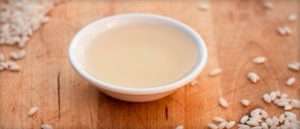
Especially carefully you need to process the hair roots. The rice broth is kept on the hair for 5 minutes, and then the curls are rinsed with plain water. The benefit of rice water is that it relieves irritation, regulates the oiliness of the skin at the hair roots, and removes dandruff and flaking. With regular use of the broth as a rinse, balm or as part of masks, the curls will become stronger, more voluminous and acquire a natural shine.
How can rice be cooked and what is it combined with
The traditional way of preparing cereals is boiling, and rice for breakfast is very beneficial. But the product is also used as part of many other dishes.
- Delicious and nutritious pilaf is prepared on the basis of rice.
- Rice is fried and added to casseroles, garnishes for meat and fish dishes.
- Rice can be found in soups, pies, risottos, Japanese sushi and rolls, and some Asian desserts.
- In Japan and China, cereals are used to make alcoholic beverages.
- In stores, you can find kozinaki made from rice and rice flakes for a healthy breakfast.
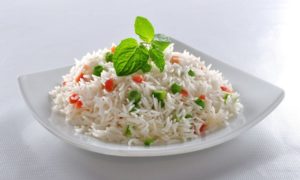
Healthy rice goes well with any vegetables and fruits, herbs and nuts, with seafood and meat. It can be used with butter and jam, fermented milk products, cheeses and spices.
Harm of rice and contraindications
The benefits and harms of rice for the human body depend on the state of health. For some people, the product is strictly prohibited. In particular, it is not recommended to use it:
- with individual allergy to cereals;
- with a tendency to regular constipation;
- with an increased level of glucose in the blood;
- with a tendency to obesity - due to the high starch content, rice can lead to a set of extra pounds.
The benefits and harms of long grain rice are mixed for males. In high dosages, the properties of rice can lead to a decrease in libido, it is better to limit yourself to 2-3 servings of the product per week.
Selection and storage of rice
The benefits and harms of rice for human health are largely determined by the quality of the cereal. When choosing rice, you need to pay attention to the following points:
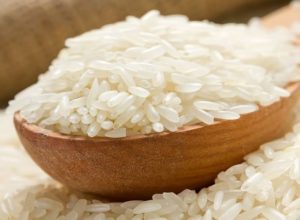
- the date of manufacture of cereals, the shelf life should not come to an end;
- tightness of the packaging - if the bag or box with rice is damaged, you should not buy cereals;
- uniformity - rice grains should be the same size;
- no debris and insects in the cereal - only pure rice should be contained in the package.
It is best to store rice not in a bag, but in a glass or plastic deep container with a closed lid. So it will retain its useful properties longer and will not absorb the aromas of neighboring products.
The shelf life of cereals is usually from 16 to 18 months, and ground cereals are stored longer than crushed ones.
Conclusion
The benefits and harms of rice are a matter of its competent use. In moderation and with proper processing, the properties of the cereal will help improve well-being and will not cause any harm to the body.

